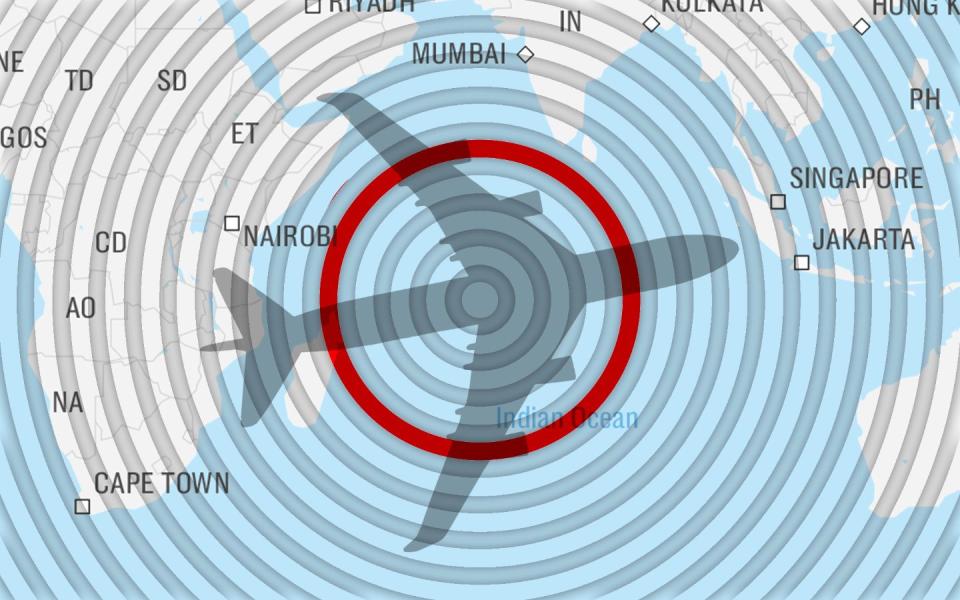
British scientists have found a sign that could help solve the mystery of the missing Malaysia Airlines Flight MH370.
The researchers from Cardiff used hydrophones – underwater microphones – which picked up a signal that could help identify the resting place of the Boeing 777 aircraft.
The craft has been missing since 8 March 2014 when it disappeared with 239 people on board.
Despite extensive international search efforts, the location of the aircraft, which mysteriously departed from its course, remains unknown and has become one of aviation’s greatest mysteries.
What is known is that a 200 ton aircraft flying at a speed of 200 meters per second releases the kinetic energy equivalent to a small earthquake.
This would be large enough to be recorded by hydrophones thousands of miles away.
Two sonar stations are capable of detecting such a signal.
One is in Cape Leeuwin in Western Australia and the second is in the British territory of Diego Garcia in the Indian Ocean.
They were established as part of a surveillance system to oversee the Comprehensive Nuclear-Test-Ban Treaty.
Both locations were operating around the time MH370 is believed to have crashed into the Indian Ocean.
These stations are located within ten minutes of signal travel time from the seventh arc, a search area 1,200 miles west of Perth mentioned in the last communication between the satellite and the plane.
Hydroacoustic stations have previously detected distinctive pressure signals from aircraft crashes, as well as earthquakes of various sizes at distances of more than 3,000 miles.
In their research, the Cardiff University team identified one signal that fits the narrow time frame when the aircraft could have crashed in the ocean on March 8. It was recorded at Cape Leeuwin station.
But this signal was not found at the Diego Garcia station.
“This raises questions about its origins,” said researcher Dr Usama Kadri, a lecturer in applied mathematics.
It is not conclusive, but he said: “Given the sensitivity of the hydrophones, it is unlikely that a large aircraft impacting the ocean surface would leave a detectable pressure signature, especially on nearby hydrophones.”
His team believes that further research could unlock the mystery in a similar way to how the Argentine navy submarine, the ARA San Juan, was found on the seabed a year after it was allegedly sunk into the depths of the South Atlantic. November 15, 2017. .
They found the vessel after detonating grenades in the ocean to simulate an explosion on the submarine, then they cross-referenced the signals from those whose sounds were picked up with hydrophones when it imploded.
As a result, they found the wreck at a depth of almost 3,000 feet 290 miles off the coast of Argentina.
“A similar exercise, using explosions or air guns of energy levels equal to those believed to be associated with MH370, could be carried out along the seventh arc,” said Dr Kadri.
“If the signals from such explosions showed similar pressure amplitudes to the signal of interest, it would support a future search for that signal.
“If the signals detected at Cape Leeuwin and Diego Garcia are significantly stronger than the signal in question, further analysis of the signals from both stations would be required.
‘almost pinpoint’
“If it was found to be involved, this would almost certainly reduce the location of the aircraft.
“On the other hand, if the signals are found to be unrelated, it would indicate that authorities need to re-evaluate the time frame or location that has established their official search efforts to date.”
Britain has already played a key role in identifying the search area in its role in supporting the international investigation into the missing plane that took off from Kuala Lumpur on a flight to Beijing en route back over the Indian Ocean apparently.
Two weeks after it disappeared, Inmarsat, a British satellite telecommunications company, showed that the plane’s satellite unit was responding to requests every hour after it disappeared from other radars. Working with the Air Investigations Branch in the UK, he was able to provide investigators with a possible search area.
Over three years Australia, the United States, China and Malaysia surveyed 46,000 square miles of seabed south-west of Perth in an area described by Tony Abbott, Australia’s prime minister at the time, as “ as close to nowhere as can be” – an area known for its strong winds, hostile seas and deep ocean floors.
In 2015 and 2016, debris from the aircraft washed ashore on several islands in the Indian Ocean including Reunion and on the African coast. Private contractor Ocean Infinity launched a new search in January 2018 but, after searching for six months, also found nothing.
Dr Kadri said: “This work led to the disappearance of MH370 because it raised questions about the ability to detect aircraft crashes in the ocean, and the potential use of hydroacoustic technology to aid search efforts and rescue.
“Unfortunately, we failed to find a signal that would have required the certainty to launch a new search for the missing aircraft. However, if the appropriate authorities follow through on the recommendations, we can assess the relevance of the observed signals, which may shed light on the location of MH370.”